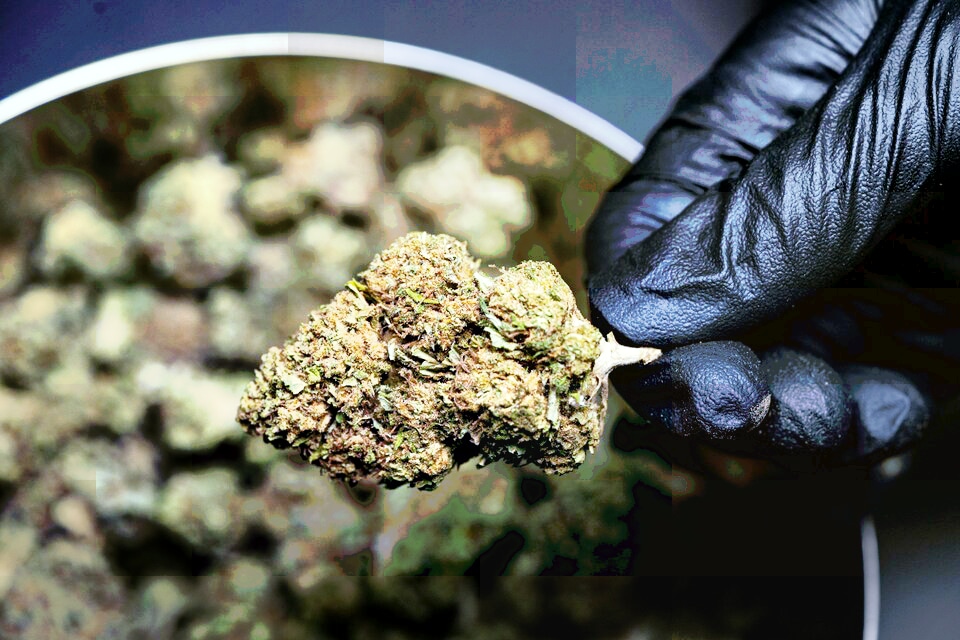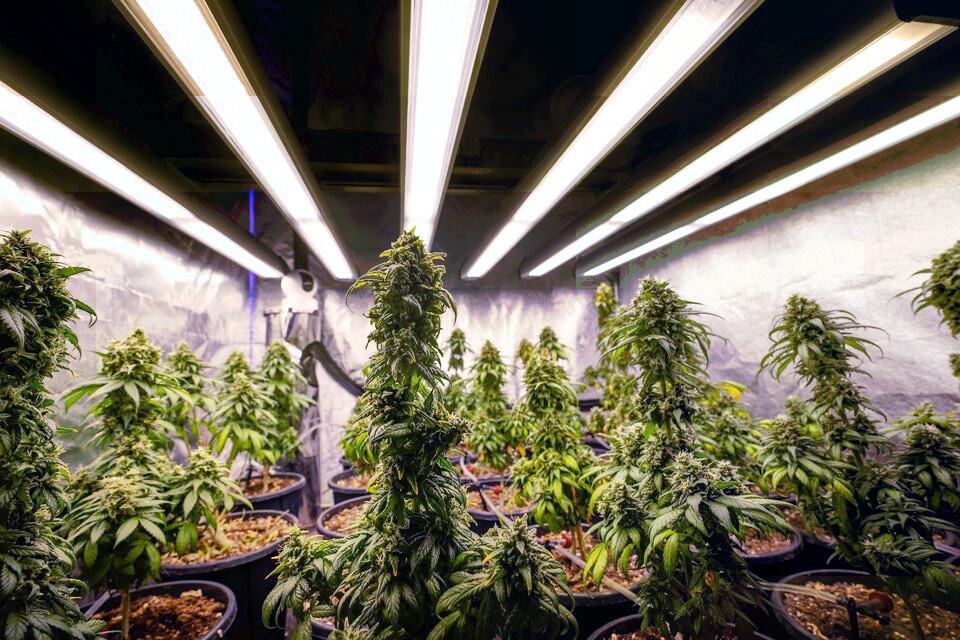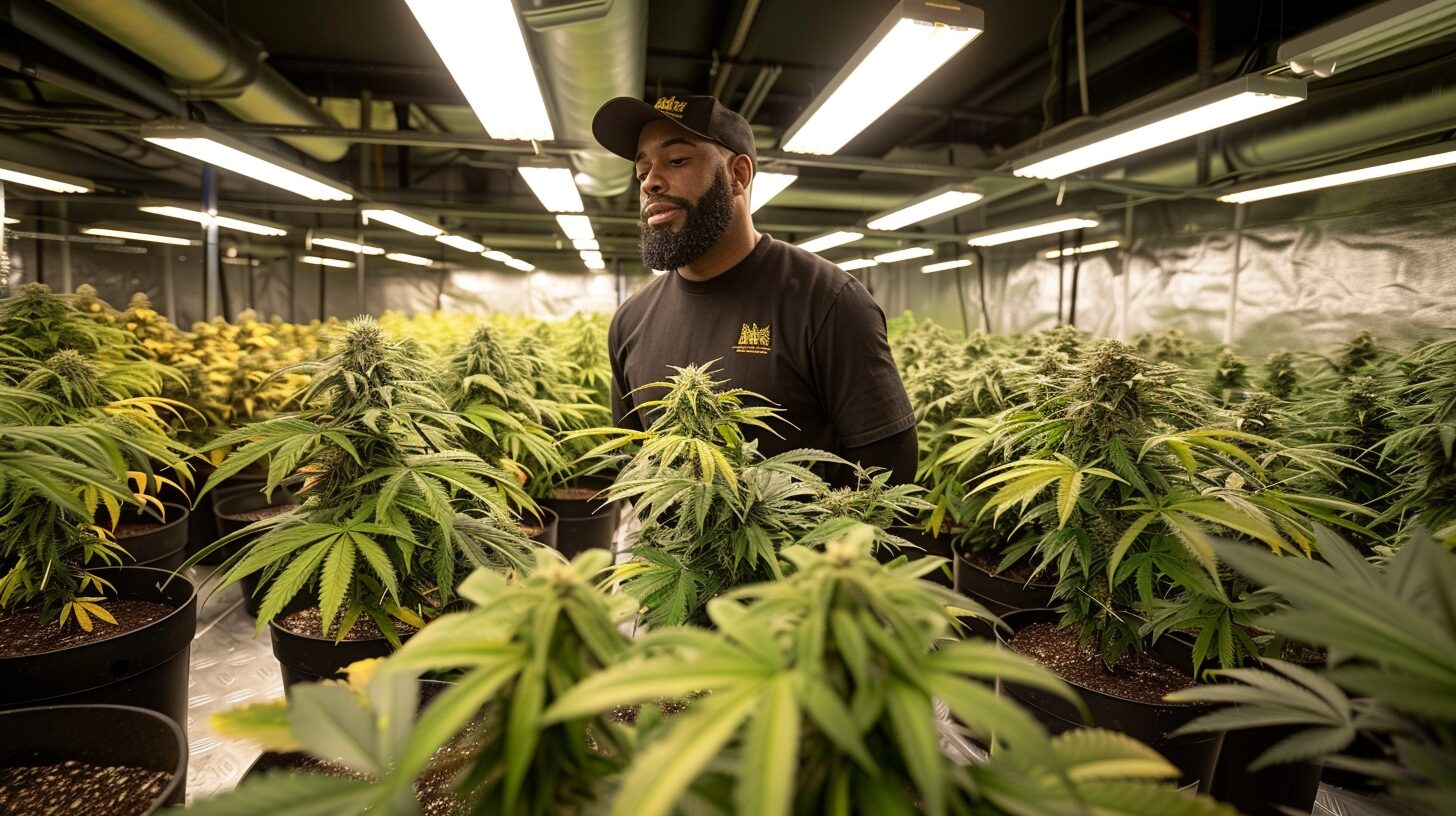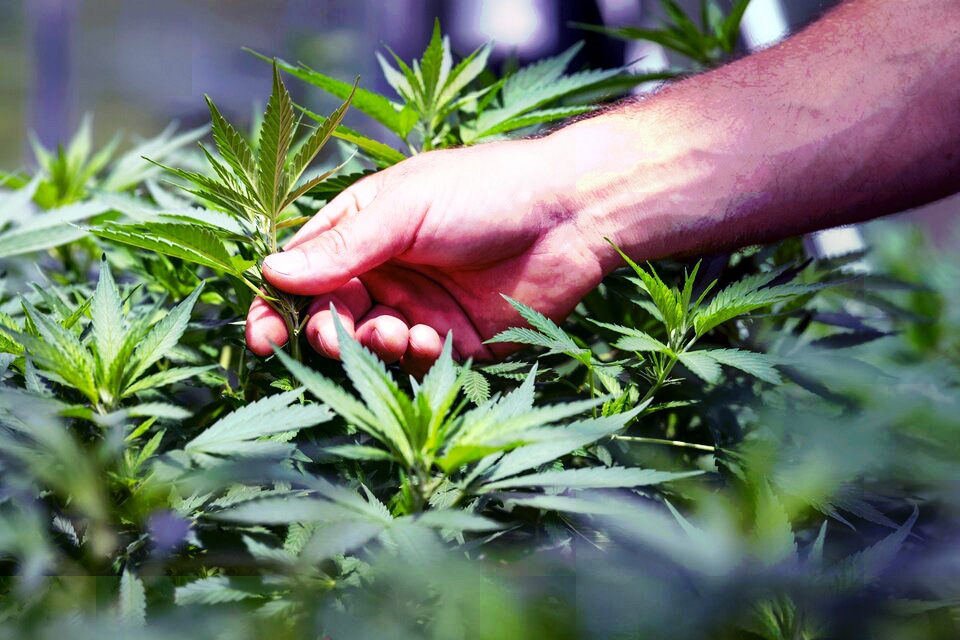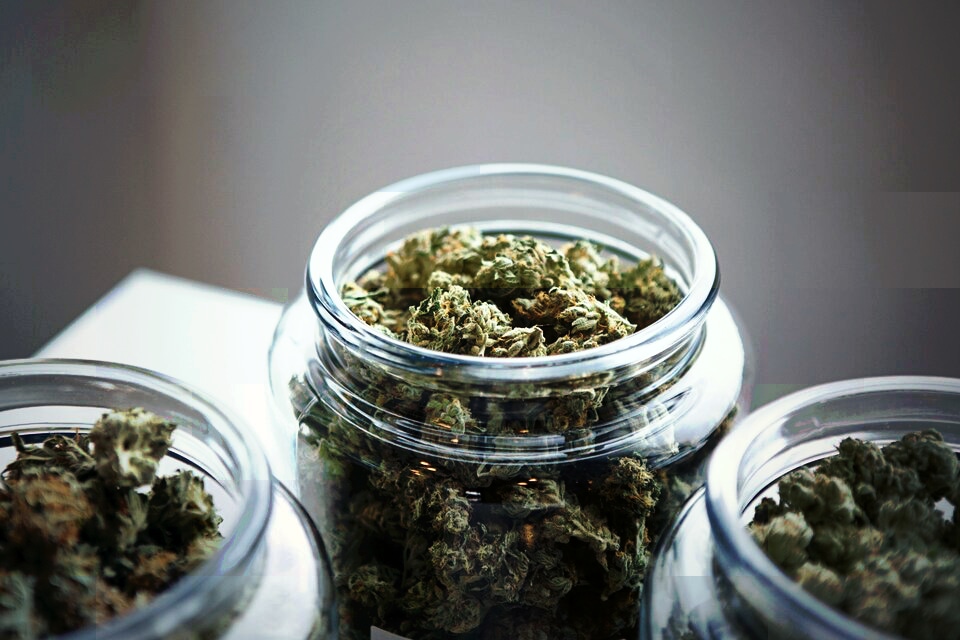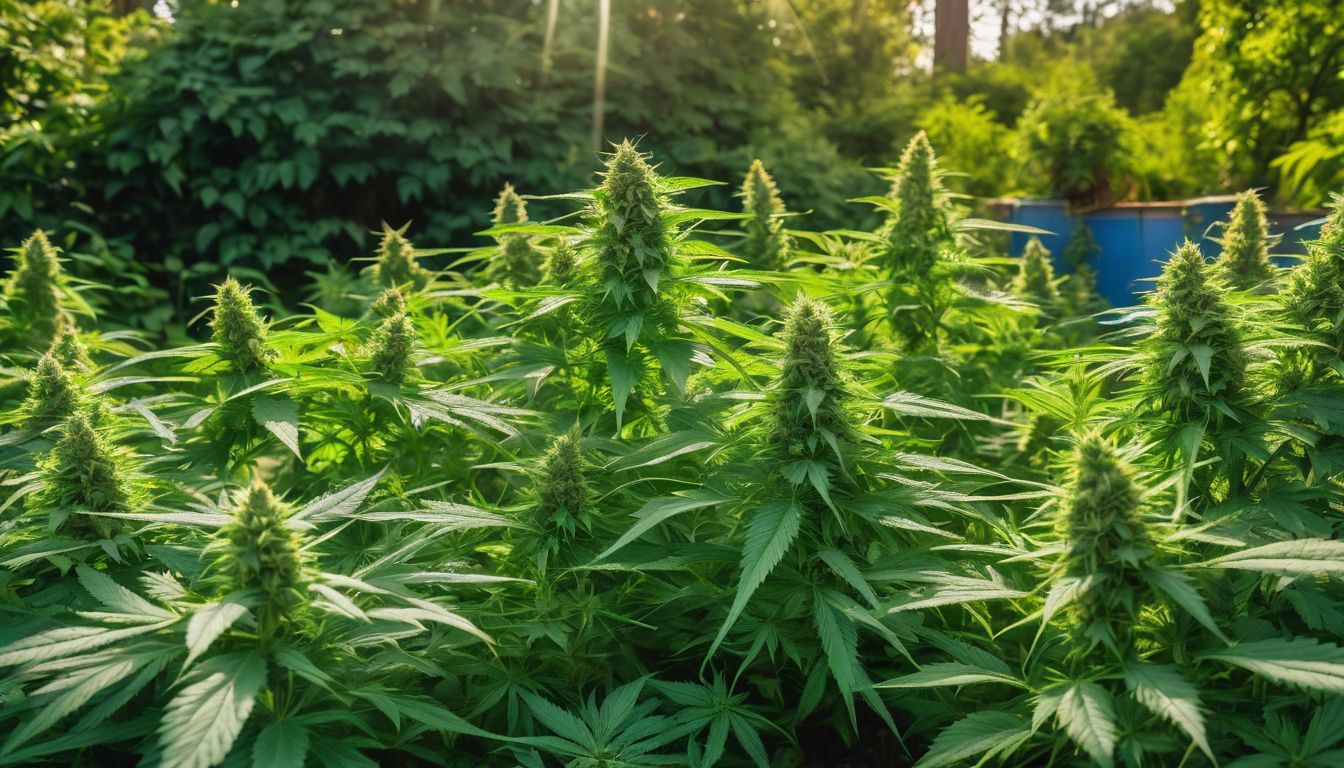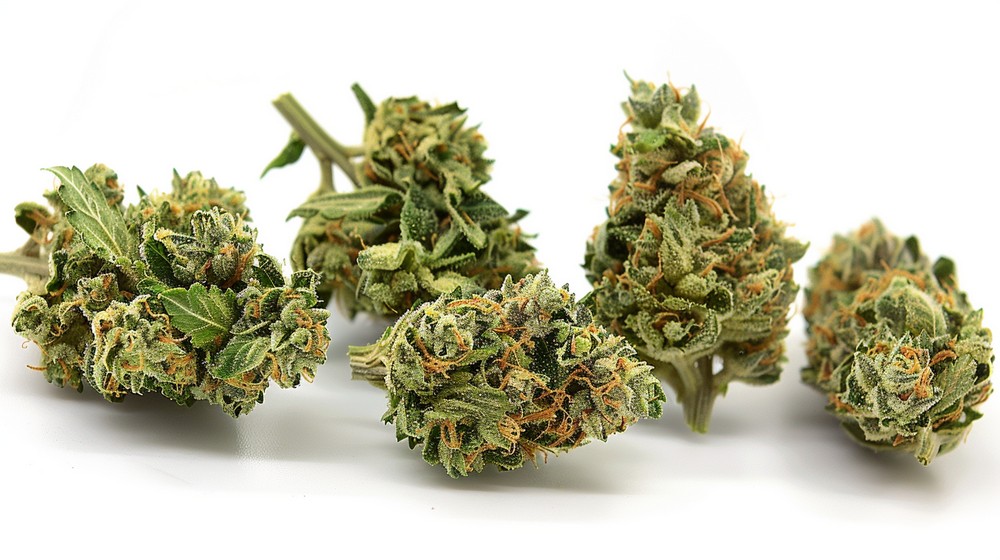Distância ideal da luz para o cultivo de cannabis: dicas de crescimento e sementes

Are you struggling to find the perfect distance for your grow lights? The right height can make the difference between a glorious harvest and disappointing marijuana plants.
In this article, we’ll unveil the mysteries of light placement to optimize the green growth of your indoor garden. Join me on the path to happier and healthier flowers.
Let’s go!
Key Takeaways
- The distance between marijuana plants and grow lights is very important to avoid burns or stunted growth.
- LED lights can be placed closer to plants than other types of lights because they don’t get as hot.
- Young plants need less light and intensity than larger plants and those in the flowering stage.
- It’s good to use meters like PAR to know the amount of light your plants receive.
- Always observe how your plants react to the light distance to make adjustments and keep them healthy.
How Far Should I Keep My Grow Lights?
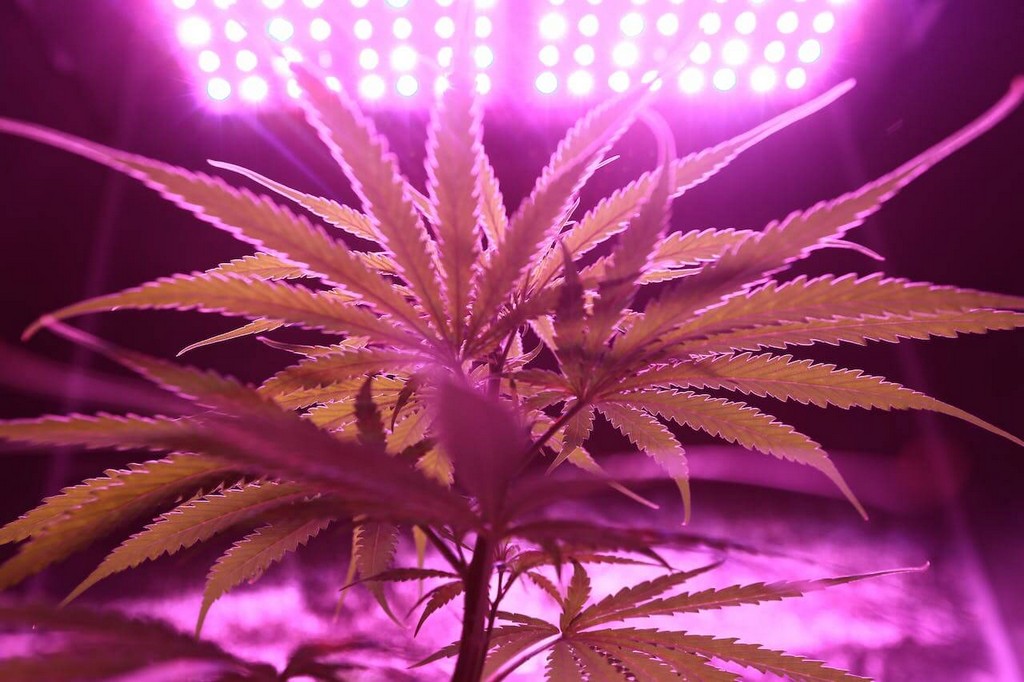
Keeping your grow lights at the right distance is super important. If they’re too close, your little plants could suffer from heat, and they won’t like that at all. But if the lights are too far away, they won’t receive enough light and won’t grow well.
For LED lights, it changes depending on their power. For example, if you have a 600W light, try to keep it between 50 and 80 centimeters (20-32 inches) from your plants. And for lights between 200 and 400W, the distance should be between 30 and 70 centimeters (12-28 inches).
It’s crucial to think about how your plants are and their growth stage. The smaller ones need less light intensity than the larger and stronger ones. Also, watch out for temperature; if it’s very hot, it’s better to move the lights a bit further away.
Use a temperature meter to be sure your plants are comfortable, and check the color and shape of the leaves to know if everything is good with the light. And remember, what works for a friend with their plants might not work the same for you. Every plant is a world of its own!
Types of Grow Lights and Their Optimal Distance
Well, friends, let’s get to the heart of the matter… When it comes to our beloved little plants and their perfect tanning under those modern luminaries, each type of grow light is like a unique character with its own personal space.
Forget “one size fits all”; here, each light dances to its own rhythm, and knowing how to keep the right distance could be the key to a harvest that will make you smile from ear to ear.
Get ready to adjust those bulbs!
LED Grow Lights
LED grow lights are gaining fans in the indoor marijuana world. And it’s no wonder; they don’t get too hot, which allows you to place them closer to the plants. Imagine this: you have a 3W or 5W LED light…
well, you put it about 45cm (18 inches) above your green plants, and when they start to flower, boom! You move it a little closer, between 5 and 8cm (2-3 inches), for the color party to begin. Ah! But if you’re playing in the big leagues and have one of those COB LEDs that are all the rage, then you start at around 60cm (24 inches).
Of course, you’ll also gradually move them closer when the big show, flowering, arrives.
Now, if you’re wondering about that 200W LED light you have lying around, or maybe a 400W one, things change a bit. You place these between 30 and 70cm (12-28 inches) from your precious little plants.
If you level up and go for a 450W or even up to 600W, keep that similar distance. Stay calm and adjust; the plants will thank you with health and beauty. And remember, it’s not all about power; a good light spectrum also counts for your private garden to shine in all its splendor.
Metal Halide and HPS Grow Lights
Moving on from LEDs, we encounter metal halide (MH) and high-pressure sodium (HPS) lights. These are known for their power and are made for specific growth stages.
MH lights are great for the vegetative phase because they have a lot of blue light, which plants love at that time. On the other hand, HPS lights have more red light, perfect for when the plants are flowering.
Using these lights has its tricks. Since they contain mercury and halogens, you have to handle them with care. The right distance is key to avoid burning the plants or giving them too little light.
For HPS or MH setups, the optimal height changes and depends on how many watts they use. For example, if you have a 400W bulb, it’s best to keep it about 30-60 cm (12-24 inches) above the top of the plants.
This way, you make sure they receive enough light without heat stress.
LEC/CMH Grow Lights
Following up on metal halide and HPS lights, it’s worth taking a look at LEC/CMH lights. These bulbs are incredible because they use less energy and still give great light for your marijuana plants to grow strong.
With LEC lights, your little plants receive a light spectrum that closely resembles the sun. This is great because it helps the plants perform photosynthesis effectively.
Another good thing about LECs is that they have UV-B light. This makes the plants healthier and can even give them more aromatic oils, which is great for marijuana.
People who grow cannabis indoors are saying a lot of good things about LEC CMH lamps. They say they’re like a revolution in lighting because they give marijuana exactly what it needs to grow well.
Fluorescent Grow Lights (like CFL and T5)
Fluorescent grow lights are a top choice if you’re looking to save money. With little heat and using less electricity, these bulbs are perfect for young or small plants.
You can find them easily, and with so many sizes, they adapt to any space. CFLs and T5s shine brightly without drastically increasing your electricity bill or cooking your little plants.
Put your fluorescent lights close to your plants, but not so close that you burn them. CFLs can be as close as 10-15 centimeters (4-6 inches) during the vegetative stage because they don’t get too hot. T5s need to be a bit further away.
Watch your plants for any heat stress signs. If you see them looking sad or burned, it might be time to move the light a little higher.
Measuring Optimal Light Levels for Cannabis
Ah, light, that magical elixir your little marijuana plants crave to transform from shy seedlings to splendid green ladies. Knowing how much you’re giving them is quite a science—and yes, there are tools for that.
Don’t worry, you don’t have to be Einstein; with a little curiosity and the right gadgets, you’ll be measuring levels like a pro in no time. Let’s leave that eyeballing for picking avocados at the grocery store, shall we? 🥑💡.
PAR and ePAR Meters
PAR and ePAR meters are like superheroes for your marijuana plants. They tell you how much light your plants are receiving. It’s not just any light, but the kind they can actually use for growth.
Imagine it’s like the food your plants need. If your cannabis plants don’t have enough “light food,” they might not grow strong and healthy. That’s why knowing how to use these meters is key.
With a PAR meter, science becomes easy. You’ll know exactly how much light reaches your little plants in every corner of your indoor garden. That way, you can move the lights or plants to make everything perfect.
Your marijuana plants will thank you by growing big and strong. And after adjusting everything with the help of the PAR meter, you’re ready to see how your plants react.
Signs of Light Stress in Cannabis
Cannabis plants “talk” to us when they’re not happy with the light. If you see the leaves turning yellow or having burn-like spots, it could be a sign of too much light.
Other times, the leaves stretch upwards or the edges curl, and that’s also saying something isn’t right.
It’s important to look at how your plants are doing to know if the light is too strong or too close. If you ignore these signs, your marijuana plants could get sick and won’t grow as big or give as many flowers.
Use these tips to keep your plants happy and healthy.
LED Light Positioning for All Stages of Marijuana Growth
LED lights are great for your marijuana plants. They have a power regulator to change the light your plants receive.
– When starting, put your LED lights about 60cm (24 inches) over the small plants. This way, you avoid burning them.
– As they grow, you can lower the lights a bit. Keep an eye on how your plants look.
– If your plants are in the vegetative stage, keep the lights at 40-60cm (16-24 inches) distance. This gives them plenty of light without damaging heat.
– When the flowering stage arrives, move the lights to 30-40cm (12-16 inches). The flowers need more light to grow big and strong.
– Check the leaves for signs of heat stress. If you see them turning yellow or getting burned tips, raise the lights.
– Use a PAR meter if you can. It’s a tool that shows you if your plants are getting the light they need.
Keep adjusting the position of the lights based on how your plants respond. Each plant type is different and needs special care.
Light Distance for Autoflowers: Does It Make a Difference?
The right light distance is key for autoflowering plants. They grow fast and have a short life cycle.
– Autoflowering plants need a lot of light from the start. This helps them grow strong and healthy.
– With LED lights, it’s recommended to start with a distance of 30-50cm (12-20 inches). This way, you ensure the plants don’t receive too much heat.
– If you use more powerful lights, like 450-600W, increase the distance to 40-80cm (16-32 inches). This prevents the leaves from burning due to heat.
– Observe your plants to adjust the distance. If you see them growing a lot and fast, it’s a sign they’re happy with the light.
– When the plants show signs of stress like curled or yellowing leaves, you need to move the light further away.
– A constant light cycle like 20/4 (20 hours on, 4 off) keeps autoflowers growing non-stop.
– Maintaining the optimal light distance can also increase yields. This means more flowers and better quality.
The next step is to consider other important factors for light distance in your grow.
Factors to Consider When Determining Grow Light Distance
When you’re playing scientist with your marijuana plants, don’t overlook some key tricks… Got a leaf handy? Because I’m about to tell you the factors that really matter for finding that perfect sweet spot between your girls and their shining friends, the lights.
Keep reading and become a true cannabis lighting guru!
Checking the Leaf Surface Temperature
Touching the leaves can tell you a lot about their heat. If you feel they’re too hot, it’s possible the lights are too close. This could cause heat stress and damage your marijuana plants.
The leaves shouldn’t be too hot or too cold to the touch.
To be sure, use an infrared thermometer. This device helps you measure the temperature without touching the plant. Make sure the temperature is just right to maintain your marijuana’s health.
Now, let’s talk about ensuring the light intensity – PPFD.
Ensuring Light Intensity – PPFD
The light intensity is key for your marijuana plants to grow strong and healthy. We’re talking about PPFD, which is the amount of light that reaches your plants. It’s like a sun bath for them, but just the right amount.
Think of it this way: if your plants get too much light, they could get burned; if they don’t get enough, they might not grow as expected.
To get the light right, use a PAR meter and aim for the magic numbers. You want around 65 μmol per every 20 square centimeters or 700 μmol per square meter. This way, you make sure your little plants receive the light love they need to shine.
Don’t forget to adjust the distance of the lights according to these figures; your green friends will thank you!
Identifying the Growth Stage
Each growth stage of marijuana is like a different game, with its own rules. In the vegetative phase, the plants are in full development; they want a lot of light to grow strong and big.
Here, don’t hold back on the light. Give your plants all they can take, without burning them, of course. This phase is vital for the rest of the plant’s life.
Then comes the moment of the show: flowering. The plants shift their focus to making flowers. It’s important to get the light distance right because now the energy goes into the flowers.
If you keep the lights too close, the leaves might suffer, and that’s never a good thing for the plants. Think of it this way: each stage has its own “personal space,” and your job is to respect it so your plants are happy and healthy.
How to Determine the Optimal Grow Light Distance
Ah, the eternal dilemma in indoor gardening… finding that sweet spot where your marijuana plants receive the perfect light, not too close to feel like they’re at a barbecue, but not so far away that they have to stretch as if searching for the sun.
I’ll let you in on a secret that every master grower keeps under lock and key: the optimal grow light distance is more art than science, and although there are guidelines, your best tool will be a critical eye and a willingness to experiment.
Follow Recommended Distance Guidelines
To know how far to put your lights, check the manufacturer’s instructions. They’ve already tested their lights and tell you the best distance. It’s a good starting point. But, you know? Each plant is unique, and what works for one might not be best for another.
Make adjustments little by little. If you see your plants are happy and growing well, you’re doing things right. And if you notice anything strange on the leaves or stems, move the lights a little higher.
This is very important to care for your plants and get the most out of them. Don’t worry! With practice, you’ll soon know exactly where your lights should be for top-notch marijuana plants.
Experimentation and Observation
There’s no single right answer about the distance between grow lights and marijuana plants. Each plant is a world, and what works for one might not be ideal for another.
So, you have to try little by little. Move the lights closer or further away and observe how your plants react. If you see the leaves burning or turning yellow, perhaps the light is too close.
But if the plants grow weak and with long stems, maybe they need more light.
Use a luxmeter to better understand how much light your plants receive. This little gadget tells you if they’re getting enough sunlight or if they need a bit more to be happy. Also, always monitor the health of your plants.
They’ll give you clues about what they need. Leaves pointing towards the light are like a thumbs-up, telling you everything is fine. But if you see them drooping or off-color, something might be wrong with the light distance.
Experimenting is key, and listening to your plants is the best guide you have.
Adjusting Distance as the Plant Grows
After experimenting and observing, it’s time to adjust the distance of the light as your marijuana plants grow. Young plants need to feel cozy, so closer light can help.
But be careful, light that’s too close could burn them. When moving to the vegetative stage, things change. The plants are ready to stretch and strengthen, so give them space by moving the lights a little higher.
Now, when it’s time to flower, that’s like the big school dance for your plant. It wants to look great, and for that, it needs the perfect light. Not too close, but not too far either.
Following the guidelines, keep your LED lights around 23-30 cm (9-12 inches) from the flowering plants. Observe how they react; each plant is unique and might need a special adjustment. You’re the lighting DJ!
Tips on the Proper Growth Light Distance for Growing a Single Marijuana Plant
To take care of your marijuana plant, the light has to be at the right distance. If the light is too close, the leaves can burn, and that’s not good for the plant. But if it’s too far away, the plant might stretch a lot looking for more light, and that’s not good either.
Each type of light is different, so it’s key to know what type you have. LED lights are great because they don’t get as hot, and you can put them closer than other lights.
It’s useful to use a thermometer to measure how much heat reaches your plant’s leaves. You place the thermometer where the little leaves are and check the temperature. It’s best to follow the recommended distances based on the light you’re using.
For example, if you have a 600W bulb, you might need more space than with a smaller one. Watch how your plant grows; if you see it needs adjustments, gradually change the light height until you find the perfect spot.
That way, your plant will be happy and healthy!
Conclusion
So, friends, keeping the lights at the right distance is like giving your plants their personal space. If you put them too close, they can burn. Too far away, and they don’t grow as much.
It’s like the musical chairs game, but with lights and marijuana. Remember, each plant and light is different. So observe, adjust, and find that sweet spot. Your cannabis will thank you!
For more information on successfully growing a single marijuana plant, visit our complete guide here.
Frequently Asked Questions
1. What’s the perfect distance to place the LED lights in my marijuana garden?
The ideal distance for LED lights is the one that gives your plants enough light without causing heat stress. During the vegetative phase, you can place them a bit closer, but in the flowering phase, hey! You move them a little further away to avoid burning.
2. Why are light intensity and spectrum so important for my little plants?
Ah! Light intensity and spectrum are super important because plants use that light to do photosynthesis. That is, they need an adequate amount of photosynthetically active radiation (PAR) to grow strong and healthy. If you give them the right spectrum, your plants will feel right at home.
3. How does the heat from the lights affect the growth of my indoor grow?
Heat can be a big problem, you know. If you place the lights too close to the plant canopy, you could cause heat stress, and that’s no good at all. You have to find that sweet spot where your plants are comfortable and don’t feel like they’re in a desert.
4. And if I change the position of the lights, will it influence the health of my plants?
Of course! The positioning of your grow light can make a huge difference. If you manage to put it in just the right place, your plants will thank you with healthy growth. But if not, they might not receive all the light they need or, worse, overheat. So adjust carefully, as if you were balancing the ingredients for your favorite recipe.

